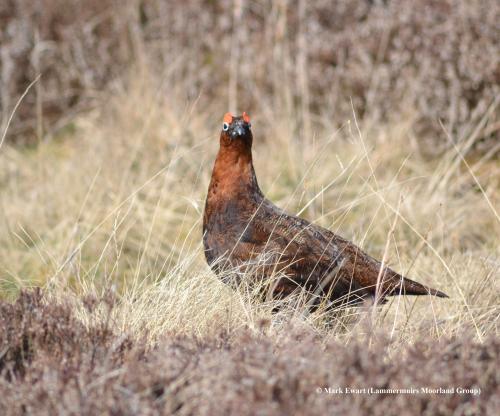In May 2017, the Cabinet Secretary for Environment, Climate Change and Land Reform announced commissioning of “research into the costs and benefits of large shooting estates to Scotland’s economy and biodiversity”1. The focus of the Cabinet Secretary’s announcement was ‘driven grouse shooting’. A Programme for Government (2017-2018) commitment, September 2017, also states research will be commissioned to “examine the impact of large shooting estates on Scotland’s economy and biodiversity.”
This work addressed this commission, bringing together evidence to consider the socio-economic and biodiversity impacts of Scotland’s driven grouse moors. Analysis by James Hutton Institute and Scotland’s Rural College (SRUC) addressed this remit and a summary report and three detailed reports have been produced:
- Part 1: Socio-economic impacts of driven grouse moors in Scotland
- Part 2: Biodiversity impacts of driven grouse shooting in Scotland
- Part 3: Use of GIS/remote sensing to identify areas of grouse moors, and to assess potential for alternative land uses.

Stage
Directory of Expertise
Purpose
The Cabinet Secretary for Environment, Climate Change and Land Reform announced (May 2017) commissioning of "research into the costs and benefits of large shooting estates to Scotland's economy and biodiversity". A Programme for Government commitment (September 2017) also states that research will be commissioned to "examine the impact of large shooting estates on Scotland's economy and biodiversity." The focus of the Cabinet Secretary's announcement concerns 'driven grouse shooting' estates. To address this commission, this work brought together evidence to consider the socio-economic and biodiversity impacts of driven grouse moors in Scotland. Three detailed reports have been produced on the following topic areas:
Socio-economic and biodiversity impacts of driven grouse moors in Scotland: Part 1: Socio-economic impacts of driven grouse moors in Scotland - an evidence review of the impacts of driven grouse moors on estate employment, wages, capital assets, etc. as well as on the wider rural business base and on local communities. The socio-economics of a selection of alternative land management models is also considered.
Socio-economic and biodiversity impacts of driven grouse moors in Scotland: Part 2: Biodiversity impacts of driven grouse shooting in Scotland – an evidence review of impacts from a range of management activities associated with driven grouse moors, including: muirburn; grazing (sheep and deer); legal predator control; mountain hare management; and a review of ecosystem service delivery by driven grouse moors.
Socio-economic and biodiversity impacts of driven grouse moors in Scotland: Part 3: Use of GIS/remote sensing to identify areas of grouse moors, and to assess potential for alternative land uses – using GIS and remote sensing to estimate the extent, intensity and characteristics of grouse moors in Scotland, including opportunities and constraints for alternative uses.
A summary report provides key information from these detailed reports, in particular the main findings, knowledge gaps and options for future research.
Results
The work was undertaken as a combination of evidence review, based on existing research, and in some instances (particularly in the case of the GIS analyses) new analyses combining datasets from a range of sources. The work was overseen by a Steering Group with members from a range of stakeholder organisations.
Evidence reviews examined:
1. The socio-economic impacts of driven grouse moors in Scotland, focusing on estate employment, wages, capital assets, etc. as well as on the wider rural business base and on local communities. The socio-economics of a selection of alternative land management models is also considered.
2. The biodiversity impacts of driven grouse shooting in Scotland, focusing on impacts from a range of management activities associated with driven grouse moors, including: muirburn; grazing (sheep and deer); legal predator control; mountain hare management; and a review of ecosystem service delivery by driven grouse moors.
GIS/remote sensing was used to identify areas of grouse moors, and to assess potential for alternative land uses, including estimating the extent, intensity and characteristics of grouse moors in Scotland, and opportunities and constraints for alternative uses.
Because of the wide-ranging nature of the project, covering multiple issues and questions, it is difficult to briefly summarise the findings of the project. A summary report has been produced that provides the key information from the three detailed thematic reports, in particular the main findings, knowledge gaps and options for future research.
Benefits
The work has pulled together a wide range of information about the socio-economic and biodiversity impacts of driven grouse shooting in Scotland, and has provided new information on the extent of driven grouse shooting and the potential for alternative land uses. This provides an up-to-date evidence base to help support decision making on the future management of driven grouse moors.
The work is directly relevant to discussions about grouse moor management, and in particular to the work of the Grouse Moor Management Group, established in November 2017 to examine the environmental impact of grouse moor management practices such as muirburn, the use of medicated grit and mountain hare culls, and advise on the option of licensing grouse shooting businesses.
Project Partners
Centre for Mountain Studies, Perth College, University of the Highlands and Islands